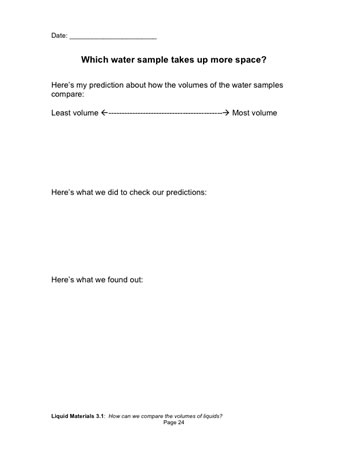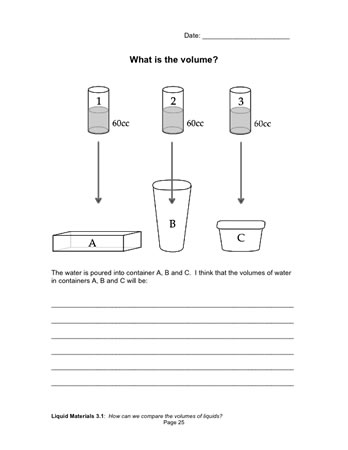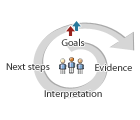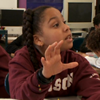How can we compare the volumes of liquids?
Plan Investigation 3.1
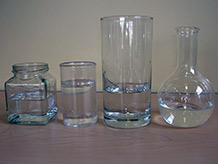
Water in a round container … Water in a square container … Water in a curvy container … How can we compare the volumes when the shapes keep changing?
Formative Assessment
Available online at inquiryproject.terc.edu
Students consider three containers of water and compare the volumes using only their senses. They predict the volume order then check it using strategies they devise themselves, e.g., transferring the liquids to three identical containers, or marking the level of each liquid in a fourth container. They consider whether liquids keep their volume as they change containers.
By the end of this investigation students will understand that liquids take the shape of their containers, that a standard–sized container makes it easier to compare volumes, and that volume is conserved no matter what container holds the liquid.
Learning Goals
- Recall that volume is the amount of three–dimensional space a material takes up
- See that liquids take the shape of their container
- See that the volume of liquids does not change with the shape of the container
| Sequence of experiences | ||
|---|---|---|
| 1. Ask the question | Discussion | 10 Mins |
| 2. Predict volume order | Small Groups | 10 Mins |
| 3. Test predictions | Small Groups | 10 Mins |
| 4. Make meaning | Discussion | 15 Mins |
Materials and Preparation
For the class:- Post the investigation question in a place where all students can see it.
- Prepare a class table for recording the groups' predicted volume orders; an example is found in Step 2.
- 1 capped 150cc container with exactly 40cc of fresh water*
- 1 capped 150cc container with exactly 40cc of mineral oil*
- 1 capped 150cc container with 40cc of sand*
- 1 capped 150cc container with 40cc of organic soil*
- 1 capped 150cc container with 40cc of gravel*
- blue food coloring
* These 5 containers of materials were also used in the last investigation.
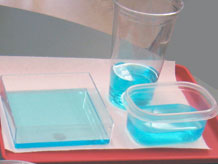
- 1 set of 3 containers, each filled with 250cc of blue–tinted water
- 1 wide, shallow rectangular container, marked "A"
- 1 narrow, tall rectangular container, marked "B"
- 1 20oz cup, marked "C"
- 2 additional 20oz cups, empty (if the group asks for these)
Do students understand that the volume of a liquid stays the same no matter what container holds the sample?
As the class discusses how they compared the volumes of A, B, and C, listen for evidence that students understand:
- The value of using identical containers to compare the volumes of different samples of liquids.
- That the volume of a liquid stays the same no matter what the shape of the container.
How would you interpret this student’s claim and evidence?
As a next step you might ask, “Is there ever a time when the volume wouldn’t be the same when you poured it into a different shaped container?”
1. Ask the question
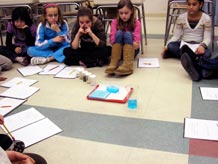
Meet for an all class discussion. Set out the containers of earth materials: water, mineral oil, gravel, sand, and organic soil.
Take a minute to revisit how the unit has unfolded so far: students first investigated solid materials (rocks and minerals), then they investigated granular materials (gravel and sand). Let students know they will now investigate two liquids — mineral oil and water — starting where they left off in the last investigation, with volume.
Show the containers of oil and water, and introduce the investigation question:
How can we compare the volume of liquids?
Listen for comments about seeing the "amount of 3-D space" the liquids take up, or "how high they go" in their containers. Agree that this strategy works if the containers are the same size and shape, but what if they are different?
Show the class the three containers holding the blue-tinted water. Point out the labels — A, B, and C — and explain that the liquid is water tinted with food coloring. Now issue a challenge:
Can you put these liquids in volume order using only your senses? No rulers, no scales, no measuring cups, no numbers — just your eyes and your hands and your brains?
Encourage students to model the volumes with their hands and to offer strategies for comparison. If they hazard guesses, ask them to justify their predictions. As students think out loud, listen for an understanding of the difficulties of the task— the containers have different shapes, we do not know the weights of the samples, there are no volume markers, and so on.
Talk with your hands! When talking about volume, it is often useful to "talk with your hands." In fact, hands can often describe 3-dimensional spaces better than words can. For practice, ask students to use their hands to indicate the volume of some common objects such as an orange, a watermelon, or a desktop computer. Then have them model the volumes of the water they see in the containers. Are they capturing all the dimensions: length, width, and height?
2. Predict volume order

Distribute a tray of materials to each group.
Encourage students to discuss the challenge in their groups and brainstorm strategies. They can use any strategy they want as long as they keep the liquids in their original containers.
As you circulate among the groups, ask students explain their strategies. Model three-dimensional thinking whenever you can, e.g.,
- So, you're thinking that because this container is wider than the others, it might hold more water, even though the height of water in the other containers is a bit higher.
- You're going to wrap your hands around the containers to get a sense of how much space the water takes up. Is that right?
As students arrive at their predicted volume order, they should record it in their notebooks [Which water sample takes up more space?], using the letters on the containers. Record the volume orders in the class table you have prepared.
| Group | How do the three volumes compare? Least Volume ––––– Greatest volume |
|---|---|
| 1 | |
| 2 | |
| 3 | |
| etc. |
Is there agreement about the volume order or are the results quite varied? It is not necessary to come to consensus now; students will determine the true volume order in a minute.
Height isn't everything. Volume is a three-dimensional measurement, but when containers are identical, we need only look at height to compare volumes. This habit can be hard to break, and students may need to be reminded: Volume is space in every direction; volume is 3-D space.
3. Test predictions

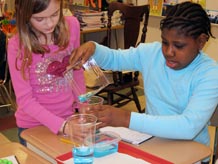
Typically, the predicted orders vary. This indicates that it's hard to compare volumes when the containers aren't the same. Have students brainstorm ways to test their predictions.
- How can we check our predictions?
- Can we think of a fair test to compare the volumes of water in the three containers?
Someone might suggest putting the three samples into identical containers so students can compare volumes — just as they did in earlier investigations. Alternatively, someone might suggest pouring the water from cups A, B, and C into a fourth container, one by one, and marking the level of each sample.
Distribute any necessary materials to the groups (e.g., some 20oz cups) and let them conduct their tests. Be sure students keep track of sample labels ("A," "B," or "C") and that they record their findings in their notebooks.
The volumes are the same. As students report their findings:
- Are the results surprising? How do you explain them?
- Which estimation strategies were successful and which were not?
Before moving on, get consensus on the following point:
- When the containers vary in shape or size, it's hard to tell with our senses how much more space one sample of water takes up than another.
4. Make meaning
Purpose of the discussion
The purpose of the discussion is to review the investigation and consolidate students' understanding of key ideas. Focus the discussion on the investigation question.
Engage students in the focus questions
Write the four focus questions on the board:
- How did you compare the volumes of liquids?
- What did you do? (What strategy did you use?)
- Why did you do it?
- What did you find out?
The session began with a challenge: to compare the volumes of three samples of water that were in containers of different shapes and sizes.
In this discussion we'll review what the different groups did, why they did it, and what they found out. Refer to the discussion question and open the discussion.

As students describe the steps in their procedures and why they took them, encourage others to:
- listen carefully (as always!)
- ask for clarification or ask questions when something isn't clear.
- think about how this procedure is the same or different from the one they used
Summarize the discussion
Summarizing this consolidation discussion will also serve as a re-cap of the investigation.
- Our challenge was to find a reliable way to compare the volume of water in three different containers.
- We used different strategies to answer the investigation question. (Review strategies that students presented.)
- No matter which strategy we used, we found that the volumes of water in the three containers were equal.
- We know from the predictions we made that it can be really difficult to compare the volumes of liquids if the containers are not the same size and shape.
Students may complete the optional assessment in their notebooks [What is the volume?].
Conservation of volume and the literal-mindedness of children.
The volume of a liquid is conserved — i.e., it remains the same — no matter what container you pour it into. As you present this fundamental law of nature, some students may become distracted by the possibility of irregularities in the procedure. They may object, for example, that the volume cannot remain the same because tiny drops will cling to the container being emptied. This is true and it’s good that students realize it, but it is beside the point. Acknowledge the truth of objections of this kind, then make your case theoretical by asking:”If we pour every little bit of the water into a different container, will the volume remain the same?“
Literal-mindedness is common in children this age. You can help them move past tiny distractions by pointing out that, we can imagine moving every last bit of water from one container into another.


